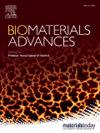Immunomodulatory and bone regenerative properties of copper/procyanidins-modified titanium surfaces
IF 5.5
2区 医学
Q2 MATERIALS SCIENCE, BIOMATERIALS
Materials Science & Engineering C-Materials for Biological Applications
Pub Date : 2025-01-23
DOI:10.1016/j.bioadv.2025.214199
引用次数: 0
Abstract
The inflammatory response triggered by the interaction between implants and macrophages is essential for bone regeneration around these implants. This study presents the application of dopamine hydrochloride to develop a copper and procyanidins coating on titanium surfaces to investigate its effects on bacterial inhibition, macrophage polarization, and osteogenic differentiation. The results demonstrated that this copper/procyanidins coating significantly suppressed the growth of Escherichia coli and Staphylococcus aureus. Notably, the initial release of Cu2+ ions promoted macrophage polarization toward a pro-inflammatory phenotype while stimulating the secretion of anti-inflammatory factors. Subsequently, the reduced Cu2+ release combined with procyanidins facilitated the transition from M1 to M2 macrophages—an essential process for bacterial phagocytosis and bone regeneration. Furthermore, this coating enhanced the secretion of osteogenic factors by bone marrow mesenchymal stem cells, enhancing their osteogenic differentiation and integration with bone tissue. These findings highlight the potential of copper/procyanidins coating in developing implant surfaces with immune-modulating and sustained antibacterial properties.

求助全文
约1分钟内获得全文
求助全文
来源期刊
CiteScore
17.80
自引率
0.00%
发文量
501
审稿时长
27 days
期刊介绍:
Biomaterials Advances, previously known as Materials Science and Engineering: C-Materials for Biological Applications (P-ISSN: 0928-4931, E-ISSN: 1873-0191). Includes topics at the interface of the biomedical sciences and materials engineering. These topics include:
• Bioinspired and biomimetic materials for medical applications
• Materials of biological origin for medical applications
• Materials for "active" medical applications
• Self-assembling and self-healing materials for medical applications
• "Smart" (i.e., stimulus-response) materials for medical applications
• Ceramic, metallic, polymeric, and composite materials for medical applications
• Materials for in vivo sensing
• Materials for in vivo imaging
• Materials for delivery of pharmacologic agents and vaccines
• Novel approaches for characterizing and modeling materials for medical applications
Manuscripts on biological topics without a materials science component, or manuscripts on materials science without biological applications, will not be considered for publication in Materials Science and Engineering C. New submissions are first assessed for language, scope and originality (plagiarism check) and can be desk rejected before review if they need English language improvements, are out of scope or present excessive duplication with published sources.
Biomaterials Advances sits within Elsevier''s biomaterials science portfolio alongside Biomaterials, Materials Today Bio and Biomaterials and Biosystems. As part of the broader Materials Today family, Biomaterials Advances offers authors rigorous peer review, rapid decisions, and high visibility. We look forward to receiving your submissions!

 求助内容:
求助内容: 应助结果提醒方式:
应助结果提醒方式:


